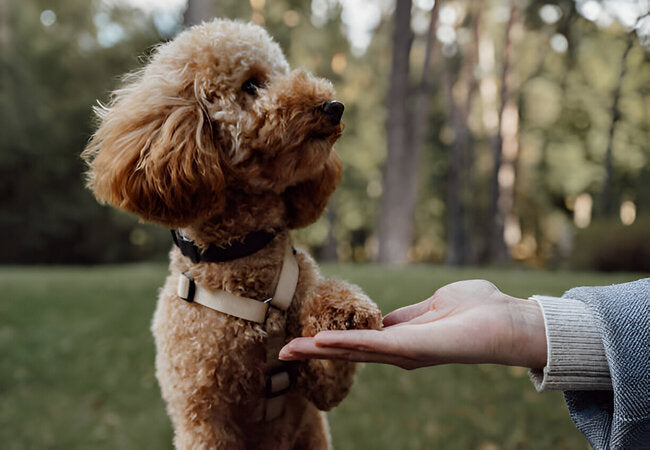How to Train a Dog with Positive Reinforcement in 2025 – Vet‑Approved Guide to Bond‑Building Obedience 🐶🦴

In this article
How to Train a Dog with Positive Reinforcement in 2025 – Vet‑Approved Guide to Humane Training 🐶🎓
By Dr. Duncan Houston BVSc
Training your dog doesn’t require fear, force, or frustration—in fact, the most effective and humane training method is also the most joyful: positive reinforcement! 🐾 In this 2025 guide, I’ll walk you through the science, tools, step-by-step methods, and expert tips to teach your dog using rewards—building trust, clarity, and lasting results. 🎯
1. 🎓 What Is Positive Reinforcement?
Positive reinforcement (R+) means adding something the dog values—like treats, praise, toys—to increase the chance they’ll repeat a behavior. It’s one of the four quadrants of operant conditioning, and research shows it’s the most effective for companion animals. 🧠
The Four Quadrants of Training:
- ✅ Positive Reinforcement: Add a reward to increase behavior
- ❌ Positive Punishment: Add a correction to decrease behavior
- 🔄 Negative Reinforcement: Remove something unpleasant when behavior occurs
- 🚫 Negative Punishment: Remove reward to decrease the behavior
Positive reinforcement avoids fear and builds motivation and joy. Studies show dogs trained with R+ perform more reliably and show fewer signs of stress. 🐶💡
2. 🧠 Why It Works So Well
- ❤️ Builds trust between human and dogs
- 🔁 Strengthens behavior through clear repetition
- 🧩 Encourages thinking and problem solving
- 🚀 Increases reliability—even with distractions
- 🧘♂️ Decreases aggression, fear, and avoidance behavior
3. 🧀 Choosing the Right Rewards
What your dog finds rewarding depends on their personality and context:
- 🍗 Treats: Soft, smelly, and pea-sized—cheese, liver, chicken
- 🗣️ Praise: “Good dog!” in a happy voice
- 🎾 Toys: For play-motivated dogs (tug, fetch)
- 🛋️ Life rewards: Access to the couch, door opening, walk starting
4. 🧭 Training Setup for Success
- 📍 Train in a quiet, distraction-free space
- 🕐 Keep sessions short: 5–10 minutes
- 🔁 Use a consistent cue + reward cycle
- 🔊 Use a clicker or marker word (“Yes!”) to mark the exact correct behavior
5. 🪜 Step-by-Step: Teaching a New Behavior
🪑 Example: Teaching “Sit”
- Hold a treat above your dog’s nose
- Slowly move it over their head—when their bum hits the floor, say “Yes!” and give the treat
- Repeat 5–10 times. Add the verbal cue “Sit” before luring
- Practice in different rooms, then outdoors
🧼 Example: Potty Training with R+
- Take dog outside after sleep, meals, play
- Say cue (“Go potty”), then praise and treat immediately after they finish
- Ignore mistakes—clean with enzymatic cleaner and try again
6. ❌ Common Mistakes to Avoid
- ⏳ Too slow to reward: Dogs may not associate treat with action
- 😵 Too many distractions: Train in low-stim environments first
- 🍖 Relying only on food: Fade treats gradually and mix in praise or play
- 📉 Reinforcing bad behavior: Don’t reward jumping, barking, or pawing for treats
7. 🐶 When to Use Clicker Training
Clickers act as a bridge between behavior and reward. They’re great for:
- 🎯 Precision with fast behaviors (like eye contact or “leave it”)
- 🪄 Shaping complex tasks (like ring bell to go outside)
- 🎁 Offering immediate clarity—especially for puppies or reactive dogs
8. 🔄 Fading Treats & Generalizing Cues
- 🎯 Switch to intermittent treats once behavior is consistent
- 🗺️ Practice in new locations to “proof” the cue
- 👨👩👧👦 Get all family members to use the same cues and rewards
9. 🔧 Fixing “Stubborn” Behavior
If your dog isn’t responding, ask:
- ❓ Is the cue clear and consistent?
- 🧀 Is the reward high enough value?
- 😬 Is the environment too distracting?
- 🤕 Is your dog tired, sore, or stressed?
10. 💡 Bonus Tips for Long-Term Success
- 🎯 Use positive reinforcement every day—not just during training
- 🛠️ Add “real-life” reinforcement (praise, freedom, affection)
- 📅 Keep training short, fun, and always end on a high note
📱 Ask A Vet App 2025 Support
Need personalized help? With Ask A Vet, you can:
- 📹 Upload videos of your training for expert review
- 🧠 Get custom clicker or treat‑based plans for any breed or behavior
- 💬 Speak directly with vets and behaviorists
Instant support helps you troubleshoot and refine techniques—whenever you need it. 🐾📲
❤️ Final Thoughts
Positive reinforcement training creates a confident, happy, and well-behaved dog—without using fear. By using treats, praise, and precise timing, you help your dog succeed and enjoy the learning process. In 2025, we train not just to control—but to connect. 🎓🐶💛
Want expert guidance? Visit AskAVet.com or download the Ask A Vet app for step-by-step help with all your training goals.






